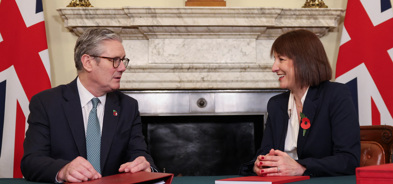New Year’s forecast: markets in a new decade
Chris Godding’s outlook for 2020 is more conservative compared to the start of 2019: here are his expectations for monetary and fiscal policies and asset performance – also, a little holiday trivia to end with!
The value of investments can fall as well as rise and that you may not get back the amount you originally invested.
Nothing in these briefings is intended to constitute advice or a recommendation and you should not take any investment decision based on their content.
Any opinions expressed may change or have already changed.
Written by Chris Godding
Published on 03 Jan 202015 minute read

Our approach to asset allocation is built around the change in monetary conditions, fiscal policy and valuation. The beauty of simplicity and focus helps us to determine the directional bias of markets and the asset classes we invest in. For instance, the prospects for a country where monetary policy is loose, fiscal spending is on the rise and equity valuations are cheap are very likely to be better than where the opposite is true. While it is always possible for us to get it wrong, the probability of success using this approach is skewed in our favour. External shocks or momentum can temporarily break the correlation between our fundamental forces and markets, particularly at peaks and troughs, but we believe that framing our view around these key drivers will work the majority of the time.
2019 reflection
Looking back to the beginning of 2019, following a sharp correction in equities in the final quarter of 2018, our view on equities moved from cautious to decidedly positive. The Federal Reserve had signalled a change in monetary policy, the fiscal impulse was set to improve worldwide, particularly in China, and equities looked significantly cheaper! After a 7% fall in December 2018, the MSCI World All Country index rallied 15.5% through to the end of April, before another 5.8% setback in May. The breakdown of trade talks between China and the US was the catalyst for the correction and markets quickly bounced back 5.7% in June as both sides stepped back from the brink.
We decided to take some profits after the recovery in June, moving our tactical positioning back to neutral. Monetary policy was still broadly supportive with financial conditions easing around the world, though it was becoming clear that capital investment had slowed due to the uncertainty created by the trade tensions. In particular we saw notable weakness in autos and aerospace in both Europe and the US. Bond yields reflected the slowdown more than equities with 10-year US Treasury yields falling rapidly from 2% in June to a low of 1.46% in September. UK gilts also rallied in the face of the global slowdown and the 10-year gilt yield dropped from 0.8% to 0.41% in the same period.
Despite a persistent decline in earnings, equity markets however have continued to make steady progress into the year end, mainly on the back of the prospects of an imminent trade deal. Therefore, with no deal yet in place and capital investment still stalled, we believe that most of the good news is already factored into the price. From just a valuation and earnings growth perspective, our outlook for 2020 is decidedly more conservative than the optimism we expressed at the start of 2019.
Earnings estimates during 2019 (rebased to 100)
“My expectations were reduced to zero when I was 21. Everything since then has been a bonus.” Stephen Hawking
We expect financial conditions and monetary policy to remain supportive of risk for at least the first half of the year. Current thinking at the developed world’s central banks is migrating toward a lower neutral interest rate, driven by the structural drag of demographics and a technology driven deflation. This suggests that interest rates will be lower for longer. However, we still expect the economic cycle to have influence and for the market rate to continue to reflect the shorter term volatility around the new lower equilibrium rates. In this regard, we would be surprised if cyclical activity did not start to pick up next year post the recent monetary stimulus and with a rise in inflation to follow in the second half. In response, we expect the Federal Reserve will need to review the current levels of Quantitative Easing and possibly begin to raise rates once again as we move into 2021. Interest rates in the UK and Europe are more likely to stay on hold, barring a strong reaction to any changes in fiscal policy. In emerging markets meanwhile, the mounting current account surpluses and high real rates suggest that interest rate moves at the margin will be lower, with more easing on the cards. Therefore, while we start the year once again, with a short duration and underweight position in developed market bonds, we continue to like emerging markets local currency debt. The caveat is that developed market bonds have a track record of proving us wrong as yields find new lows!
The fiscal bump
Fiscal policy, the third leg of our investment framework, is forecast to decline from a tailwind of 0.3% of global GDP to a headwind of -0.1% in 2020*. The most negative change is expected to be in the US where spending year on year is expected to decline by 0.7% of US GDP next year. In US dollar terms, this forecast contraction in government spending during 2020 amounts to around US$136bn on a base of US$900bn in total spending or 0.2% of global GDP. It may of course change in an election year but the scope for a material increase is limited by the accumulating deficit and the budget ceiling approved by Congress.
The strongest fiscal impulse in 2020 from a global perspective is in Africa (0.5% YoY) and Asia (0.2%) although the total net effect on global GDP is just 0.1%. The number for Asia would also increase materially if we were to include the broader measure of government borrowing in China which shows the fiscal impulse at 0.9% of GDP or about US$100bn and 0.13% of global GDP. This expansion would offset the contraction in the US almost completely.
The UK also looks a relatively safe bet for next year considering the spending plans of the Conservative Party which has already promised £14bn in current spending and £1.7bn in capital investment. Looking forward, the Conservatives are promising around £1.5bn of extra current spending for 2020-2021, along with around £3bn of tax cuts. Their new fiscal rules also imply around £20bn a year in extra public investment – but their manifesto only details around £3bn for 2020-2021, and while this is explicitly non-exhaustive, public investment is hard to ramp up rapidly at short notice. Therefore, the estimate is around £7.5bn gross which will be offset by £3.3bn of extra tax revenues relative to previous projections due to the foregone increase in corporation tax.
In summary, while the variation in regions is valuable information, the global fiscal picture overall is inconsequential in terms of the influence on global growth and not the positive it has been for the past two years in the US in particular.
3 factor status for 2020
| Factor | Negative | Neutral | Positive |
| Monetary | |||
| Fiscal | |||
| Valuation |
Outlook by asset class
Equities
On a strategic basis, equities continue to appear to be the best asset class to provide reasonable, real returns (after inflation) over the long term through real earnings growth and inflation pass-through. For 2020, after a global earnings contraction in 2019, an anticipated bounce in business activity is likely to provide a boost to global earnings with profit margins remaining at historically high levels, helped by cheap borrowing and reasonably subdued wage growth. Against that, some markets look richly valued on a variety of measures, suggesting that a considerable amount of good news is already priced in, limiting the upside and presenting some downside risk. At a regional level, it is the US market that looks particularly expensive – by as much as 20-30% by some measures – while the UK, which remains unloved by global investors, in fact appears relatively cheap compared to its own history.
Tilney equity framework output (z-scores)
Above, our equity framework looks at regional markets compared to their own history, and uses ‘z-scores’ which are probability assessments. The z-score indicating the number of standard deviations away from the mean or, in simple terms, a level of confidence. For instance, a z-score of 1 is equivalent to about 84% confidence while a z-score of 2 is equivalent to 98% and 3 is equivalent to 99.9%. You can see that the underlying framework implies that most markets are erring toward expensive against their own history and this must be offset against any near-term prospect for a bounce in activity and the fact that interest rates are very low compared to the average for the modern era and justify a higher earnings multiple.
On balance, our outlook for equities is that the turnaround in business sentiment and recovery in activity is likely to push equities higher in 2020; however, following the market rally in 2019, it is clear the opportunity is less compelling than at the end of 2018.
Fixed income
Sovereigns
It has been another vintage year for bond markets; renewed quantitative easing and lower interest rates on both sides of the Atlantic pushed sovereign yields back down to the bottom of their post-2011 trading ranges, resulting in high single digit returns in local currency.
The return to more typical growth levels in 2020 should not be inherently dangerous for bond markets. Inflation is likely to remain subdued, which also means that an overzealous Federal Reserve accidentally triggering a recession is a low risk.
Over the year ahead, yields are likely to drift higher from their current levels, for two reasons:
- Sovereign bonds are expensive on a fundamental basis with 1/3 offering negative nominal yields and a significant portion of the remainder doing so in real terms. On this basis they are fundamentally unattractive on a buy and hold basis.
- The improving economic, political and trade outlook should allow at least a partial unwinding of the safety trade which depressed yields for much of 2019.
Lingering uncertainties will, however, cap any rise in yields as should the limited capacity for interest rates to go materially higher. Longer term, the need for heavily indebted borrowers to limit their servicing costs also suggests that 10-year sovereign yields will remain below their long-term “equilibrium” of equating to nominal GDP growth.
UK gilt yields detached themselves from their US equivalents in 2016 and the gap has continued to widen. It is very unusual for gilts to yield less than Treasuries and the current 1.02% discount for the respective 10-year bonds is unprecedented. Overseas holdings of gilts have remained steady (at just under 30%) throughout the last 3.5 years, suggesting that it is domestic factors, in particular a flight to safety in the face of political/Brexit uncertainty, that have been the main drivers of their out-performance.
We would now expect this premium rating, and out-performance, to slowly erode over the medium term for a variety of reasons:
- The reduced Brexit uncertainty is now starting to prevail.
- The expectation that the UK will be a guinea pig for a sharp reversal in the prevailing economic orthodoxy – as emphasis is now placed on fiscal spending – an end to austerity and a heavier supply of gilts to the market.
- The prospect of a post-Brexit world where interest rates and inflation are structurally higher.
10-year yields
“In God we trust; all others must pay cash.” American Proverb.
Credit
2019 was also a good year for credit as both absolute yields fell and spreads recovered from the blowout they experienced in the fourth quarter 2018. Hence corporate markets outperformed their underlying sovereign.
Therefore, investment grade corporate credit starts 2020 offering a low yield premium/carry over comparable sovereigns, which compensates the holder for the default risk which comes with the territory. The absolute yield is also historically low, as it is in sovereign markets.
We are assuming that the short lived inversion of the 2 and 10 year US and UK spreads in August was a false signal of a downturn. We cannot be sure of this until mid-2020 at the earliest and of course nothing lasts for ever – as the saying goes – but easing trade tensions and monetary stimulus support our argument. Spreads reached a trough for this cycle in the summer of 2018 and while investor alternatives are limited, some modest widening of spreads is to be anticipated from now on, even if underlying corporate fundamentals are expected to improve.
Our preference in investment grade is for short dated credit, clipping the coupons available, while limiting the downside risk to capital.
In a world where running yields and therefore high breakeven levels (i.e. the rise in yields which can be accommodated before capital losses wipe out the running yield) are likely to be key metrics and corporate fundamentals will stay firm, high yield bonds can be expected to offer a reasonably attractive option, especially with select equity markets now looking more expensive. As a result, we favour a modest exposure to high yield in portfolios.
Sterling investment grade spread, (10-year period)
Emerging Markets debt
Although expectations have improved from the credit perspective with many more emerging markets current accounts in surplus, real rates are expected to fall further and the currencies still look cheap compared to the US dollar. With a running yield of around 5% and the potential for currency appreciation, the asset class looks attractive to us in a low yield world, albeit with a little more volatility.
Fixed income summary
Overall, our ratings for the various segments of fixed income are as follows:
| Asset | Negative | Neutral | Positive | Duration (Comments) |
| International Sovereign | Short duration US$ TIPS | |||
| Gilts | Short | |||
| UK Investment Grade Credit | Short | |||
| UK High Yield | Short | |||
| Emerging Market Debt | Neutral |
NB: The ratings reflect our view in terms of total return in GBP.
Commodities
While a trade deal and an improving global growth outlook are prima facie positive for commodities, the relatively subdued dynamics of the improvement (especially in China) limit the benefit to activity based commodities, especially oil and metals. Both are therefore likely to remain subdued, limiting their threat to the benign inflation outlook. Agriculture has more potential given the trade deal, lower global inventories and African swine fever.
Gold has proved to be a fairly accurate barometer of investor angst, rising briefly above US$1,500/oz in the autumn. Most investors now appear to be fairly fully weighted, while the unfolding reduction in uncertainty (plus higher sovereign yields) are also likely to conspire against it. It remains, however, the ultimate hedge against tail risks, plenty of which could well have a role to play over the year ahead.
Gold price (from 2013)
Property
The increased growth in flexible office space is driven by employers searching for workplaces that encourage productivity, collaboration and contribute to a work/life balance. These factors are contributing to the gradual transformation of traditional office buildings into open and multi-purpose workplaces. Returns in the offices sector are more dependent on office supply coming to the market; we saw a moderation in returns in 2019 vs. 2018 and this trend is expected to continue.
The retail sector will continue to be disrupted by the major structural change the sector is facing primarily due to the sustained growth in online shopping allowing consumers to shop anytime, with the UK leading Europe with 20% of all retail sales online. Consumers now expect a seamless omni-channel experience as standard. Retailers will therefore continue to face challenges in 2020 as they are forced to adapt to constantly evolving consumer shopping patterns and adopt new approaches to sustain themselves. Returns in the sector for 2020 are therefore expected to remain negative.
We can expect logistics real estate to continue to be driven predominantly by key trends in e-commerce and technology. As UK consumers are increasingly embracing online shopping, the shift from retail to warehouse space continues to gain momentum. We expect to see further moderation in returns going into 2020.
Rental value growth by sector
Summary
The scatter chart below shows the 10 year expected annualised return of each asset in our strategic asset allocation model. We use it as a guide to where the best risk adjusted returns may be for our portfolios while taking into account the benefits of diversification and negative correlation to maximise the expected return for a given level of risk.
10-year forecast risk and return by asset class
While it is relatively clear that the current environment remains positive for risk assets like equities, it is also important to remember the defensive quality of assets like sovereign bonds and gold in times of stress. These assets are either uncorrelated or negatively correlated to higher risk assets and provide the ‘balance’ in a balanced portfolio.
It is also apparent from looking back over the past 10 years that the expected return for risk has declined as valuations have risen and the risk-free rate has fallen close to zero. At the same time, however, inflation expectations have also declined, meaning that the net expected return of investing in risk assets in real terms remains attractive over the long term.
New Year trivia
2020 is a leap year and 25 January will mark the beginning of the Chinese Year of the Metal Rat. The rat is known for its energetic, restless and inquisitive nature. They are successful, strong, prudent and fiercely loyal but, sadly, not very romantic and probably not very good cooks in real life! From an investment perspective the Chinese will view this as a good year for prudent long term investment and for property in particular.
The associated element is water, the lucky month is December and the lucky flower is the lily!
Other events in 2020 include: An election in Taiwan (11 January), Brexit Day (31 January), Euro Football championship across 12 countries (12 June), the launch of the NASA Mars 2020 mission (17 July), the Olympics in Japan (24 July), the US election (3 November) and the expiry of the Brexit transition period (31 December).
Major film releases to look out for in sequence include: Dolittle, The Invisible Man, Sonic the Hedgehog, Mulan, No Time to Die, Greyhound, Fast and Furious 9 (!), Artemis Fowl, Wonder Woman 1984, Top Gun Maverick (can’t wait!), Ghostbusters 2020, Tenet (Christopher Nolan), Bill and Ted Face the Music, The Trial of the Chicago 7, The Witches, Everybody’s Talking About Jamie, Clifford the Big Red Dog, Eternals, Dune, West Side Story, Tom & Jerry and News of the World.
Wishing you all a very happy and prosperous New Year!
*Oxford Economics
Get insights and events via email
Receive the latest updates straight to your inbox.
You may also like…

Market news
2024 Autumn Budget Overview: The key announcements from Chancellor Rachel Reeves


Market news



